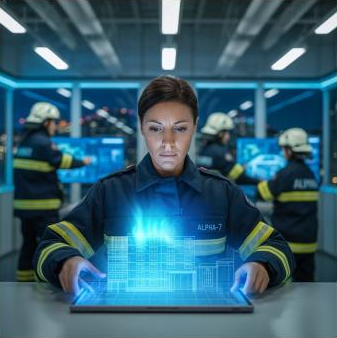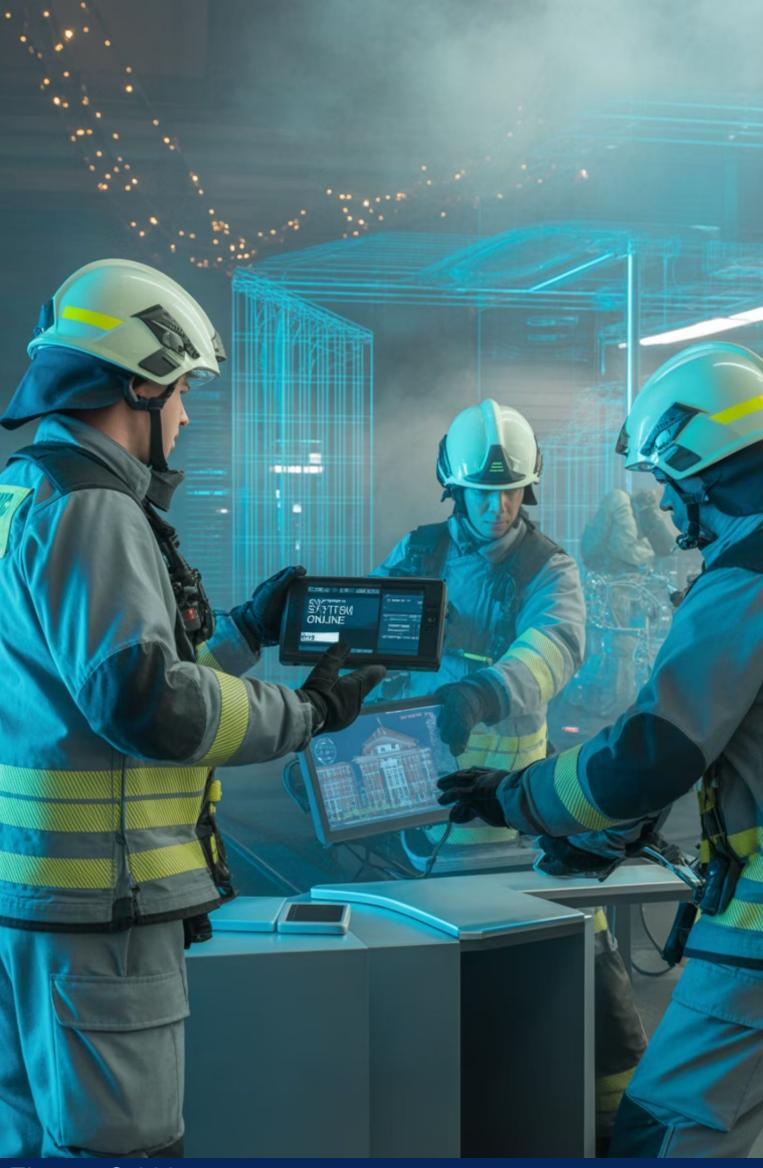Physics-Based Digital Twin Platform
Overview
Testing FireForce VI in real wildfire conditions is dangerous, expensive, and impractical for validating thousands of scenarios. This work package creates a comprehensive physics-based simulation environment—similar to NVIDIA Omniverse—that enables complete system testing and validation in a virtual world that accurately mirrors real-world fire behavior, terrain, weather, and system interactions. This digital twin serves as the virtual proving ground for the entire FireForce VI ecosystem, enabling testing of drones, AI coordination, and command interfaces in realistic scenarios before deployment.
The Challenge
Validating an autonomous firefighting system requires:
- Realistic fire behavior that matches actual wildfire physics
- Accurate terrain and environmental modeling at scale
- Real-time weather simulation with dynamic conditions
- Hardware-in-the-loop integration for physical components
- Support for hundreds of concurrent simulation scenarios
- Computational efficiency for interactive testing
- Repeatable scenarios for regression testing
- Edge case and extreme condition testing without risk
Real-world testing is limited, costly, and cannot safely explore failure modes or extreme scenarios that the system must handle.
Core Capabilities
1. Physics-Based Fire Behavior Model
Advanced Fire Propagation
- Computational fluid dynamics (CFD) for fire spread
- Heat transfer and radiation modeling
- Smoke dispersion and plume dynamics
- Ember transport and spot fire generation
- Fuel consumption and burn rate calculations
- Fire intensity and flame height modeling
Environmental Interactions
- Wind-driven fire behavior
- Topographic effects on spread
- Fuel moisture impact
- Temperature and humidity effects
- Atmospheric stability influences
- Convection column dynamics
Accuracy & Validation
- 10% accuracy compared to real fire behavior
- Calibration against historical fire data
- Validation with controlled burns
- Continuous model refinement
- Scientific literature alignment
- Expert fire scientist review

2. Comprehensive Terrain Modeling
High-Fidelity Topography
- Sub-meter elevation data representation
- Slope and aspect calculations
- Drainage and watershed modeling
- Ridge and valley effects
- Natural and artificial barriers
- Multi-resolution terrain meshes
Vegetation & Fuel Mapping
- Fuel type classification (grass, brush, timber)
- Fuel load density and distribution
- Vegetation height and structure
- Dead vs. live fuel ratios
- Seasonal fuel moisture variations
- Urban-wildland interface modeling
Infrastructure & Obstacles
- Building footprints and materials
- Road networks and firebreaks
- Power lines and infrastructure
- Water sources and access points
- Populated areas and critical facilities
- Dynamic obstacle generation
3. Dynamic Weather Simulation
Atmospheric Modeling
- Wind speed and direction (micro and macro scale)
- Temperature and humidity gradients
- Atmospheric pressure systems
- Turbulence and gusts
- Diurnal weather patterns
- Weather front simulation
Real-Time Weather Updates
- Integration with live weather data
- Historical weather replay
- Forecasted weather scenarios
- Extreme weather conditions
- Rapid weather change events
- Seasonal variation modeling
Micro-Climate Effects
- Canyon and valley wind patterns
- Thermal updrafts and downdrafts
- Local humidity variations
- Fire-induced weather effects
- Convection column winds
- Spotting distance calculations

4. Hardware-in-the-Loop Integration
Physical Hardware Interfaces
- Real drone flight controllers integration
- Sensor data injection and extraction
- Actuator command simulation
- Communication system integration
- GPS and navigation simulation
- Power system modeling
Virtual-Physical Bridging
- Real-time synchronization (<10ms latency)
- Protocol translation and adaptation
- Timing accuracy and determinism
- Fault injection for robustness testing
- Performance profiling
- Bidirectional data flow
Hybrid Testing Modes
- Full simulation (no hardware)
- Partial hardware-in-loop (critical components)
- Full hardware-in-loop (complete system)
- Graduated integration testing
- Risk-free hardware validation
- Pre-deployment verification
5. Operational Simulation Framework
System-Level Testing
- Complete FireForce VI system simulation
- Multi-agent coordination testing
- Mission scenario execution
- Performance benchmarking
- Scalability testing (50+ drones)
- Long-duration endurance testing
Scenario Generation
- Parametric scenario creation
- Historical fire recreation
- Procedural scenario generation
- Edge case and corner case scenarios
- Worst-case condition synthesis
- Training scenario library
Interactive Visualization
- Real-time 3D rendering
- Multiple camera views
- Telemetry overlays
- Time manipulation (speed up/slow down)
- Replay and analysis tools
- VR/AR visualization support

Industry Collaboration
Technology Demonstration
FireForce VI plans to leverage cutting-edge digital twin technology pioneered by NVIDIA and Lockheed Martin, demonstrating real-time fire spread prediction and suppression strategy evaluation:
Note: The above wildfire simulation is a collaboration between NVIDIA and Lockheed Martin. Learn more
Technical Architecture
Simulation Engine
- Physics Core: Custom fire dynamics engine or Omniverse integration
- Renderer: High-performance 3D engine (Unreal/Unity/Omniverse)
- Weather Engine: WRF (Weather Research and Forecasting) integration
- Terrain Engine: GIS-based terrain processing
- Agent Simulation: Multi-agent behavior framework
- Real-Time Orchestrator: Synchronized execution control
Data Layer
- Terrain Database: High-resolution topographic data (USGS, LIDAR)
- Fuel Database: LANDFIRE fuel classifications
- Weather Database: Historical and forecast data (NOAA)
- Scenario Library: Pre-built test scenarios
- Calibration Data: Real fire behavior validation
- Hardware Profiles: Device specifications and models
Integration Layer
- Hardware Abstraction: Device drivers and protocol adapters
- API Gateway: RESTful and real-time APIs
- Message Broker: Event streaming for distributed components
- Synchronization Service: Time and state synchronization
- Monitoring: Performance and health telemetry
- Export/Import: Scenario and result data exchange
Success Metrics
| Metric | Target | Measurement Method |
|---|---|---|
| Fire Behavior Accuracy | ±10% of real fire data | Comparison with controlled burns |
| Simulation Area | 100 km² real-time | Performance benchmarking |
| Concurrent Scenarios | 20+ simultaneous | Load testing |
| HIL Latency | <10ms synchronization | Timing analysis |
| Visual Fidelity | Photo-realistic rendering | Expert evaluation |
| Computational Efficiency | 60 FPS interactive | Frame rate monitoring |
Technical Challenges
1. Realistic Fire Propagation Modeling
- Challenge: Creating computationally efficient fire models that match real-world behavior within 10% accuracy while running in real-time for large areas
- Approach: Hybrid approach combining CFD for accuracy with simplified models for speed, GPU acceleration, adaptive mesh refinement, machine learning for pattern recognition
- Skills Required: Computational physics, CFD, parallel computing, fire science
2. Real-Time Weather Simulation
- Challenge: Simulating atmospheric conditions at multiple scales (micro and macro) with sufficient accuracy to impact fire behavior while maintaining interactive performance
- Approach: Multi-scale weather modeling, integration with WRF, pre-computed weather patterns, interpolation techniques, GPU-accelerated computation
- Skills Required: Meteorology, atmospheric modeling, numerical methods, parallel computing
3. Hardware-in-the-Loop Integration
- Challenge: Synchronizing physical hardware with virtual simulation at <10ms latency while handling different communication protocols and timing requirements
- Approach: Real-time operating systems, time synchronization protocols, protocol translators, deterministic scheduling, low-latency communication
- Skills Required: Real-time systems, embedded systems, communication protocols, hardware interfaces
4. Scalable Computational Requirements
- Challenge: Balancing simulation fidelity with computational resources to enable multiple concurrent simulations and interactive testing
- Approach: Level-of-detail techniques, distributed computing, GPU/CPU hybrid execution, cloud elasticity, efficient algorithms, smart caching
- Skills Required: Performance optimization, distributed systems, GPU programming, cloud architecture
Team Structure
Required Roles
- Computational Physics Specialist
- Game Engine/Graphics Expert
- Meteorology/Climate Modeler
- Simulation Architecture Engineer
- Optional: DevOps/Cloud Engineer
Deliverables
- Fire Physics Engine - Validated fire propagation model (±10% accuracy)
- Terrain Simulation System - High-fidelity topographic and fuel modeling
- Weather Simulator - Dynamic atmospheric condition modeling
- Hardware-in-the-Loop Framework - Physical device integration
- Visualization Platform - Interactive 3D environment viewer
- Scenario Library - Pre-built test scenarios and templates
- Documentation - User guides, API docs, validation reports
Technology Stack Recommendations
- Simulation Core: NVIDIA Omniverse, Unreal Engine 5, or Unity
- Physics: Custom CFD + PyroSim/FDS for validation
- Weather: WRF (Weather Research & Forecasting)
- Terrain: GDAL, PostGIS for GIS processing
- Rendering: RTX/OptiX for ray tracing
- Backend: Python, C++ for performance-critical code
- HIL Interface: ROS2, DDS for real-time communication
- Deployment: Docker, Kubernetes, cloud GPU instances
Integration Points
- Testing Platform - Provides test execution scenarios
- System Integration - Validates integrated system behavior
- Mission Control - Tests command and control interfaces
- AI Fire Warden - Validates decision-making algorithms
- All Drone Work Packages - Hardware-in-the-loop testing
Validation Philosophy
“Test virtually, deploy confidently” - The simulation environment must be realistic enough that success in simulation provides high confidence in real-world performance, while being safe enough to explore every possible failure mode without consequence.